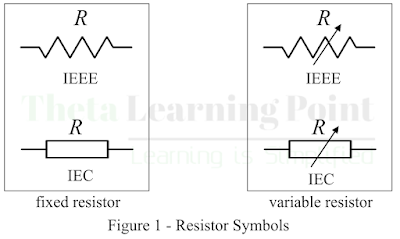What is a Resistor?
A passive circuit element that is used to introduce electrical
resistance in an electrical or electronic circuit is called a resistor. It is a passive circuit
component as it only consumes electrical energy, and does not deliver electrical energy. The measurement of opposition that a resistor offers in the
flow of current through it, is called resistance.
The resistance is represented by the symbol R.
The resistor is a circuit element used to model the
current-resisting behaviour of a material. We may also define the resistor in
terms relation between voltage and current as, a circuit element for which the
voltage across the element is directly proportional to the current through it,
then the element is called a resistor.
Working of Resistor
In a resistor, electrons moving under the influence of an electric field collide with positive atoms of the resistor material again and
again. After each collision, these electrons slow down and the number of
electrons crossing per unit area is reduced. Consequently, the current through
it is reduced, and the energy released on each collision is dissipated in the
form of heat. In this way, a resistor opposes the flow of electric current.
Types of Resistors
The resistors can be of the following two types, namely-
- Fixed Resistors
- Variable Resistors
(1). Fixed Resistor:
A resistor whose resistance remains constant is called a fixed resistor. It is the most widely
used type of resistor. These are mainly used in electronic circuits to
introduce a constant resistance in a circuit. The resistance value of fixed
resistors is determined during their manufacturing, and these resistors come in
standard resistance values. The circuit symbol of the fixed resistor is shown
in figure-1.
There are several types of fixed resistors available such as
carbon composition resistors, carbon film resistors, metal-oxide film
resistors, metal film resistors, wire wound resistors, surface mount resistors,
etc.
(2). Variable Resistor:
A resistor whose resistance value can be adjusted as per
requirement is called a variable
resistor. A variable resistor consists of two main parts viz. an element of fixed resistance and
a slider. The slider taps onto the fixed resistor element. Therefore, a
variable resistor has three connection terminals – the two terminals are of the
fixed resistor element and the third is the slider terminal. When we are required
to provide a resistor with variable resistance, one end of the fixed
resistor element and the slider terminal are connected in the circuit. The
circuit symbol of the variable resistor is shown in the figure-1.
The variable resistors can also be of either wire-wound or
composition type. A most commonly used variable resistor, called a potentiometer or pot, is a three-terminal element with a slider. By sliding the slider,
the resistance between the slider terminal and the fixed terminals can be
adjusted.
Depending upon Ohm’s law, resistors may also be classified into two types, namely-
(1). Linear Resistor –
(2). Non-Linear Resistor –
Although, all practical resistors may exhibit non-linear
resistive behaviour under certain conditions.
Applications of Resistors
The resistor is one of the fundamental components in
electrical and electronic circuits. The primary use of the resistor is to
control the flow of electric current in a circuit. The following are some major
applications of resistors-
- Resistors are used in different circuit functions like speed control of a motor, changing the loudness of an amplifier, etc.
- Resistors are used for designing voltage divider circuits.
- Resistors are used in electric heating appliances as the current passing through a resistor generates heat.
- Resistors are used in light-dimming circuits.
- Resistors are also used in fan regulators, etc.
Conclusion
In this article, we discussed resistors, their types, and their applications. From the above discussion, it is clear that a resistor is a two-terminal passive circuit element that is used in various electrical and electronic circuits to introduce a certain amount of electrical resistance. The main use of a resistor in a circuit is to control the current through it.










0 Comments